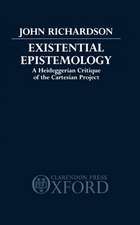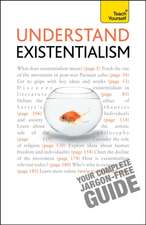James and Husserl: The Foundations of Meaning: Phaenomenologica, cartea 60
Autor R. Stevensen Limba Engleză Hardback – 31 aug 1974
Din seria Phaenomenologica
- 20%
 Preț: 816.33 lei
Preț: 816.33 lei - 13%
 Preț: 478.40 lei
Preț: 478.40 lei - 20%
 Preț: 629.12 lei
Preț: 629.12 lei - 13%
 Preț: 491.46 lei
Preț: 491.46 lei - 13%
 Preț: 542.55 lei
Preț: 542.55 lei - 20%
 Preț: 553.67 lei
Preț: 553.67 lei - 15%
 Preț: 633.02 lei
Preț: 633.02 lei -
 Preț: 417.02 lei
Preț: 417.02 lei -
 Preț: 417.90 lei
Preț: 417.90 lei -
 Preț: 418.29 lei
Preț: 418.29 lei -
 Preț: 389.49 lei
Preț: 389.49 lei -
 Preț: 425.42 lei
Preț: 425.42 lei - 15%
 Preț: 577.72 lei
Preț: 577.72 lei - 15%
 Preț: 527.32 lei
Preț: 527.32 lei - 15%
 Preț: 636.80 lei
Preț: 636.80 lei - 18%
 Preț: 952.89 lei
Preț: 952.89 lei - 18%
 Preț: 949.42 lei
Preț: 949.42 lei - 15%
 Preț: 643.65 lei
Preț: 643.65 lei - 18%
 Preț: 1225.48 lei
Preț: 1225.48 lei -
 Preț: 389.31 lei
Preț: 389.31 lei - 18%
 Preț: 1113.39 lei
Preț: 1113.39 lei - 18%
 Preț: 952.40 lei
Preț: 952.40 lei - 18%
 Preț: 1664.61 lei
Preț: 1664.61 lei - 18%
 Preț: 1551.73 lei
Preț: 1551.73 lei - 18%
 Preț: 1222.31 lei
Preț: 1222.31 lei - 18%
 Preț: 944.19 lei
Preț: 944.19 lei - 15%
 Preț: 642.51 lei
Preț: 642.51 lei - 18%
 Preț: 1112.78 lei
Preț: 1112.78 lei - 18%
 Preț: 891.80 lei
Preț: 891.80 lei - 18%
 Preț: 948.47 lei
Preț: 948.47 lei - 18%
 Preț: 1224.18 lei
Preț: 1224.18 lei - 18%
 Preț: 946.87 lei
Preț: 946.87 lei - 15%
 Preț: 578.84 lei
Preț: 578.84 lei - 15%
 Preț: 464.18 lei
Preț: 464.18 lei - 18%
 Preț: 839.56 lei
Preț: 839.56 lei
Preț: 642.03 lei
Preț vechi: 755.33 lei
-15% Nou
Puncte Express: 963
Preț estimativ în valută:
122.87€ • 128.11$ • 102.11£
122.87€ • 128.11$ • 102.11£
Carte tipărită la comandă
Livrare economică 20 martie-03 aprilie
Preluare comenzi: 021 569.72.76
Specificații
ISBN-13: 9789024716319
ISBN-10: 9024716314
Pagini: 204
Ilustrații: VIII, 192 p.
Dimensiuni: 155 x 235 x 17 mm
Greutate: 0.46 kg
Ediția:1974
Editura: SPRINGER NETHERLANDS
Colecția Springer
Seria Phaenomenologica
Locul publicării:Dordrecht, Netherlands
ISBN-10: 9024716314
Pagini: 204
Ilustrații: VIII, 192 p.
Dimensiuni: 155 x 235 x 17 mm
Greutate: 0.46 kg
Ediția:1974
Editura: SPRINGER NETHERLANDS
Colecția Springer
Seria Phaenomenologica
Locul publicării:Dordrecht, Netherlands
Public țintă
ResearchCuprins
I. The World of Pure Experience.- 1. The fundamental tenets of Radical Empiricism.- 2. The absolute sphere of pure experience.- 3. A comparison with Bergson.- II. Sensation, Perception, Conception.- 1. Knowledge by acquaintance and “knowledge about”.- 2. The recognition of sameness.- 3. The fringe structure of the stream of consciousness.- 4. The complementarity of perception and conception.- 5. Comparison between Husserl’s epoché and James’s return to pure experience.- III. The Genesis of Space and Time.- 1. The pre-reflective givenness of spatiality.- 2. The elaboration of spatial coordinates.- 3. Husserl’s theory of horizons and James’s fringes.- 4. The temporal structure of the stream of consciousness.- 5. The theory of the specious present.- 6. Primary and secondary remembrance.- 7. Husserl’s analysis of the now-phase.- 8. Active and passive genesis.- IV. The Structure of the Self: A Theory of Personal Identity.- 1. A functional view of consciousness.- 2. The empirical self.- 3. The pure ego.- 4. Husserl’s distinction between the human ego and the pure phenomenological ego.- 5. The auto-constitution of the ego in temporality.- 6. The ambiguous situation of the body.- V. Intersubjectivity.- 1. Two inadequate solutions to the impasse of solipsism.- 2. Reference to a common spatial horizon.- 3. The problem of solipsism in the context of transcendental subjectivity.- 4. The coordination of alien spatial perspectives through imaginative variation.- VI. The Thing and its Relations: A Theory of the Constitution of the Physical World.- 1. The positing of thing-patterns within the stream of consciousness.- 2. The sense of reality.- 3. The various sub-universes of reality.- 4. The region of the “thing” as a guiding clue for phenomenological inquiry.- 5.The return to the concrete fullness of the life-world.- VII. Attention and Freedom.- 1. The correlation between the focus-fringe structure of the object and the subjective modalities of attention and inattention.- 2. James’s dependence upon the “reflex-arc” theory of human activity.- 3. The relationship between attention and freedom.- 4. Husserl’s study of attention as an index of intentionality.- 5. The spontaneity of the ego’s glance.- 6. James’s pragmatic justification of the possibility of freedom.- VIII. The Pragmatic Theory of Truth.- 1. Pragmatism as a method and as a genetic theory of truth.- 2. Four different types of truth and of verification.- 3. Husserl’s definition of truth as the ideal adequation between meaning-intention and meaning fulfillment.- 4. The retrogression from the self-evidence of judgment to the original founding evidences of the life-world.- Conclusion — Action: the Final Synthesis.


















